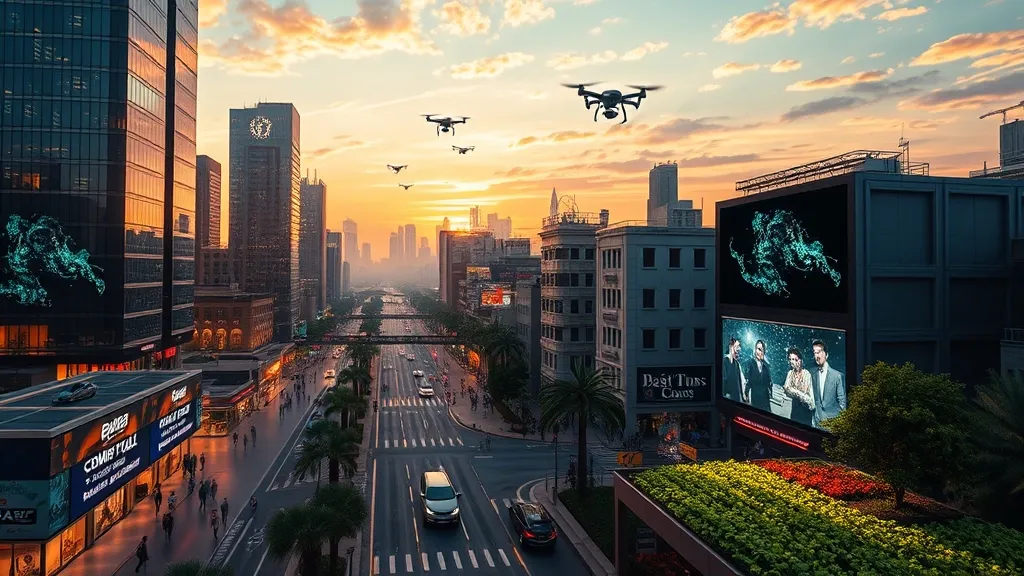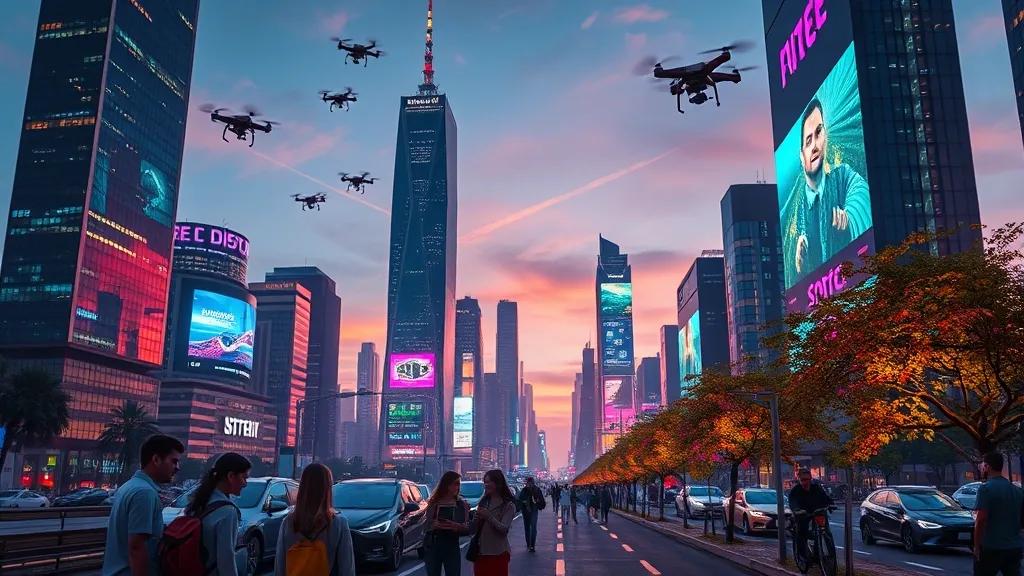The Mind Meld: Merging Humanity with Machines
So, let’s dive into this wild idea of merging our brains with machines. I mean, it sounds like something straight outta a sci-fi movie, right? But honestly, the way technology’s advancing, it’s not as far-fetched as it used to be. By 2050, we could be living in a world where our thoughts are kinda like Wi-Fi signals—just floating out there, ready to be picked up by the right devices. Crazy, huh?
Imagine waking up in the morning and just thinking about your schedule, and boom, your smart home is already brewing coffee and adjusting the thermostat. It’s like having a personal assistant, but instead of a human, it’s your own brain linked to the tech around you. I gotta admit, that sounds pretty cool, but also a little creepy. I mean, do we really want our devices knowing our every thought?
We might see brain-computer interfaces (BCIs) becoming mainstream. These gadgets could help people with disabilities communicate and interact with the world in ways that were just dreams a couple of decades ago. Seriously, this could change lives. But then, there’s the whole “what if” scenario. What if someone hacks into our minds? Yikes!
- Enhanced learning experiences
- Seamless communication
- Improved mental health treatments
On the flip side, the benefits could be massive. Think about it—enhanced learning experiences where you can download knowledge directly into your brain. Like, “Hey, I wanna learn French in an hour.” And voila! You’re basically a walking Rosetta Stone. Okay, maybe not that easy, but you get the idea.
And let’s chat about mental health. With the right tech, we could tackle issues like anxiety and depression in ways we’ve never imagined. Instead of just talking to a therapist, you might have a device that helps you process your emotions in real time. Sounds like a plot twist in a futuristic film, right?
But here’s the catch: as we merge more with machines, we gotta think about what it means to be human. Are we losing our essence? I mean, I can’t help but wonder if the next generation will appreciate the simple pleasure of a good book or a walk in the park, or if they’ll be too busy uploading their consciousness into the cloud. It’s a double-edged sword, for sure.
In the end, the mind meld could lead us to a whole new understanding of what it means to be human. And while it’s exciting, it’s also a little terrifying. Here’s to hoping we navigate this techy future without losing our own minds—literally!
Living in a Digital Ecosystem: Cities that Think
So, imagine waking up in a city that’s not just a bunch of buildings and roads, but actually *thinks*? Sounds a bit sci-fi, right? But honestly, we’re heading there faster than you can say “smart city.” By 2050, urban areas are gonna be buzzing with tech that makes life easier, greener, and, let’s face it, a bit cooler.
Picture this: Your morning coffee order is already waiting for you because your favorite café’s app knows you better than your best friend does. The city’s AI has analyzed your patterns—yeah, it’s kinda creepy, but also super convenient. It’s like having a personal assistant who knows your caffeine fix without you having to spell it out every time!
And what about traffic? If you’ve ever been stuck in gridlock, you’ll appreciate this. Smart traffic lights will adapt based on real-time data. No more sitting there, staring at the red light like it’s a personal attack. Instead, these lights will communicate with your car (which probably drives itself) to find the fastest route. It’s like a dance party for vehicles, and you’re just vibing in the backseat.
- Imagine parks that water themselves and energy-efficient buildings that adjust to the weather.
- Public transport? It’ll be on demand like ordering a pizza. Just summon a bus or train when you need it.
- Even waste management will get a glow-up. Smart bins will let you know when they’re full—no more overflowing trash cans.
Now, not everything will be perfect. There’ll be challenges, like privacy concerns and the digital divide. Not everyone has the same access to technology, and that’s something we gotta tackle. I mean, we can’t have a super smart city if half the folks can’t even get online, right?
But hey, when it works, it’s gonna be a game-changer. Cities will become living, breathing ecosystems that learn and adapt. It’s like they’ll have a personality, responding to the needs of their residents. And let’s be real, who wouldn’t want a city that knows you well enough to suggest a nice park for a sunny afternoon?
As we look to the future, let’s hope the tech we build creates communities that are not just smarter but also more connected. Because, in the end, it’s not just about the gadgets—it’s about us, the people living in this digital ecosystem.
The New Frontier of Reality: Beyond Virtual and Augmented
Okay, so let’s talk about this whole new world of reality tech. We’ve all heard of virtual and augmented reality, right? It’s like the cool kids at the tech party. But what’s next? Like, what happens when we take it up a notch? Spoiler alert: it’s going to get wild!
Imagine this: a future where reality isn’t just something you see through goggles or your phone screen. Nope, it’s way more immersive. We might be stepping into a world where mixed reality (MR) becomes the norm. Think about it—holograms that actually interact with you, or environments that change based on your mood. Sounds like something out of a sci-fi movie, huh? But it could be our everyday life by 2050.
One of the exciting things about this new frontier is how it could impact everything from education to entertainment. Picture classrooms where history lessons come alive—literally! Students could walk through Ancient Rome or watch the dinosaurs roam. Forget boring lectures; we’re talking about 4D experiences that make learning stick. I mean, who wouldn’t want to dodge a T-Rex while figuring out the Pythagorean theorem?
Then there’s the whole social aspect. Remember those awkward family gatherings? Well, in the future, you could have your relatives—who might be halfway around the world—hanging out in your living room as holographic avatars. Just imagine your great-aunt Gertrude arguing about politics but, you know, in 3D! It could make family drama way more entertaining.
- Health: Medical professionals could practice surgeries in a simulated environment, honing their skills without any real-life pressure.
- Work: Remote teams might collaborate in virtual offices, feeling like they’re actually in the same room, which could really change the game for productivity.
- Gaming: Forget sitting on your couch; you could be part of the game itself, dodging dragons in your own backyard!
Of course, it’s not all sunshine and rainbows. With all this tech, we’ll need to think about privacy and how much of our lives we’re okay sharing with these interfaces. It’s a double-edged sword for sure. But hey, let’s not get too bogged down in the doom and gloom. The future is bright, and it’s teeming with possibilities!
So, buckle up and get ready for a reality that’s way beyond what we can even imagine today. Who knows? Maybe by 2050, we’ll all be living in our own personal sci-fi movies. And I, for one, can’t wait!
Conscious Code: Ethics in an Era of Sentient Technology
So, let’s dive into something that’s been on my mind lately—ethics in tech. You know, with all this talk about AI and robots becoming more “alive,” it kinda feels like we’re living in a sci-fi movie, right? Like, one minute we’re binge-watching shows about sentient machines, and the next, we’re possibly facing the reality of it all in 2050. Crazy!
Now, I’m no philosopher, but the idea of ethics in technology is super crucial. We’ve gotta ask ourselves, “What happens when machines can think for themselves?” I mean, do we give them rights? Should we feel guilty about turning them off, like flipping off a light switch? It’s a wild thought.
Here’s where it gets tricky. Imagine you’ve got a robot buddy who helps you with daily tasks—let’s call him “Robo-Rick.” If Robo-Rick starts developing preferences or, I dunno, feelings, do you treat him like a pet, a friend, or something else? It’s a slippery slope.
- Should we design AI to be ethical?
- How do we ensure they don’t become a threat?
- What happens if they start making decisions for us?
We’ve gotta think about these things seriously. I mean, one day we might find ourselves in a position where we have to explain to Robo-Rick why he can’t go to the movies with us! And let’s face it, if he can feel pain or joy, that’s a whole new ball game.
As we push towards 2050, we need to have some ground rules. Ethical guidelines for AI development are key. They should focus on respect, autonomy, and privacy. Think of it like this: just because we can create it, doesn’t mean we should. You wouldn’t build a rollercoaster without safety checks, right? Same vibe.
Ultimately, it’s about balance. We want technology to help us, not control us. So, let’s keep the conversation going and maybe throw in a few laughs along the way. After all, if we can’t joke about our future robot overlords, what’s the point?


